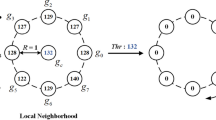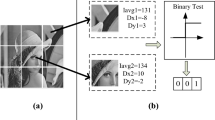Abstract
Image description plays a dominant role in the computer vision and pattern recognition fields and has achieved a remarkable success for noise free or low-noise image. However, the methods face a great challenge when suffering from noise. Feature extraction is divided into floating point and binary. However floating point feature descriptors are complex and inefficient. Local difference binary (LDB) is one of state-of-art methods for higher accuracy and speed. Motivated by LDB, we propose an improved LDB named as multiple extended LDB (MELDB) to improve the effectiveness of basic LDB descriptor via gradients and difference of gradient information in four directions and explore much more discriminative noise-invariant features. MELDB has strong robustness under complex illumination and noise conditions. Next, we improve GA and BPSO algorithms called as FDSGA and ALBPSO, respectively. To further improve the discriminative ability of MELDB, a novel feature selection method named as intelligent coordination feature selection (ICFS) is represented to select the optimized subset of MELDB feature, based on co-evolution of FDSGA and ALBPSO. Then, to fully utilize class information, we further promote the ICFS named as class supervised ICFS to select the optimal subset feature. Extensive experiments are conducted to verify the effectiveness and efficiency of proposed methods on CMUPIE, YALE B, YALE B Ext databases and those noisy databases. The results reflect that our methods outperform other state-of-the-art methods and show strong robustness on noise, especially under severe noise conditions.




















Similar content being viewed by others
Data availability
The datasets generated during and/or analyzed during the current study are available from the corresponding author on reasonable request.
References
Li Y, Sixou B, Peyrin F (2021) A review of the deep learning methods for medical images super resolution problems. IRBM 42(2):120–133
Rajput SS, Singh A, Arya KV et al (2018) Noise robust face hallucination algorithm using local content prior based error shrunk nearest neighbors representation. Signal Process 147:233–246
Tao G, Liu Z, Cao J et al (2020) Local difference ternary sequences descriptor based on unsupervised min redundancy mutual information feature selection. Multidimens Syst Signal Process 31(3):771–791
Huang D, Yi Z, Pu X (2009) A new incremental PCA algorithm with application to visual learning and recognition. Neural Process Lett 30(3):171–185
Yu X, Cui G, Yang J et al (2020) Quadratic optimization for unimodular sequence design via an ADPM framework. IEEE Trans Signal Process 68:3619–3634
Oh JH, Kwak N (2013) Generalization of linear discriminant analysis using Lp-norm. Pattern Recogn Lett 34(6):679–685
Fernandes SL, Bala GJ (2013) A comparative study on ICA and LPP based Face Recognition under varying illuminations and facial expressions. In: 2013 International Conference on Signal Processing, Image Processing & Pattern Recognition. IEEE, pp 122–126
Kim W, Suh S, Hwang W et al (2014) SVD face: illumination-invariant face representation. IEEE Signal Process Lett 21(11):1336–1340
Liu L, Meng XW, Zhong ZG et al (2017) SAR images target recognition based on wavelet and KSVD. Matrix 1:2
Ansari MD, Ghrera SP (2018) Intuitionistic fuzzy local binary pattern for features extraction. Int J Inf Commun Technol 13(1):83–98
Ojala T, Pietikäinen M, Mäenpää T (2002) Multiresolution gray-scale and rotation invariant texture classification with local binary patterns. IEEE Trans Pattern Anal Mach Intell 7:971–987
Pourreza HR, Masoudifar M, ManafZade MM (2011) LSP: local similarity pattern, a new approach for rotation invariant noisy texture analysis. In: 2011 18th IEEE International Conference on Image Processing. IEEE. pp 837–840
Zhang J, Xiao X (2015) Face recognition algorithm based on multi-layer weighted LBP. In: 2015 8th International Symposium on Computational Intelligence and Design (ISCID). IEEE, 2015, 1: 196–199
Sujay SN, Reddy HSM, Ravi J (2017) Face recognition using extended LBP features and multilevel SVM classifier. In: 2017 International Conference on Electrical, Electronics, Communication, Computer, and Optimization Techniques (ICEECCOT). IEEE, pp 1–4
Liu X, Xue F, Teng L. Surface Defect Detection Based on Gradient LBP[C]//2018 IEEE 3rd International Conference on Image, Vision and Computing (ICIVC). IEEE, 2018: 133–137.
Agarwal M, Singhal A, Lall B (2019) Multi-channel local ternary pattern for content-based image retrieval. Pattern Anal Appl 22(4):1585–1596
Iso S, Shiba S, Yokoo S (2018) Scale-invariant feature extraction of neural network and renormalization group flow. Phys Rev E 97(5):053304
Ren Z, Sun Q (2020) Simultaneous global and local graph structure preserving for multiple kernel clustering. IEEE Trans Neural Networks Learn Syst 32(5):1839–1851
Ma J, Jiang X, Fan A et al (2021) Image matching from handcrafted to deep features: a survey. Int J Comput Vision 129(1):23–79
Yang X, Cheng KTT (2013) Local difference binary for ultrafast and distinctive feature description. IEEE Trans Pattern Anal Mach Intell 36(1):188–194
Tao G, Liu Z, Cao J et al (2018) Local difference ternary sequences descriptor based on unsupervised min redundancy mutual information feature selection. Multidimens Syst Signal Process 31:771–791
Das AJ, Saikia N (2016) Pedestrian detection using dense LDB descriptor combined with HOG. In: 2016 International Conference on Information Technology (InCITe)-The Next Generation IT Summit on the Theme-Internet of Things: Connect your Worlds. IEEE. pp 299–304
Bibars A, Mahroos M (2019) New local difference binary image descriptor and algorithm for rapid and precise vehicle visual localisation. IET Comput Vision 13(5):443–451
Sampson JR (1976) Adaptation in natural and artificial systems (John H. Holland). SIAM Rev 18(3):529–530. https://doi.org/10.1137/1018105
Vlašić I, Ðurasević M, Jakobović D (2019) Improving genetic algorithm performance by population initialisation with dispatching rules. Comput Ind Eng 137:106030
Shao G, Shangguan Y, Tao J et al (2018) An improved genetic algorithm for structural optimization of Au–Ag bimetallic nanoparticles. Appl Soft Comput 73:39–49
Yang H, Hu X (2016) Wavelet neural network with improved genetic algorithm for traffic flow time series prediction. Optik 127(19):8103–8110
Xinwu Y, Qiaohui W, Huibin X et al (2016) A coordinated signal control method for arterial road of adjacent intersections based on the improved genetic algorithm. Optik 127(16):6625–6640
Guo H, Mao Z, Ding W et al (2019) Optimal search path planning for unmanned surface vehicle based on an improved genetic algorithm. Comput Electr Eng 79:106467
Zou D, Li S, Kong X et al (2019) Solving the combined heat and power economic dispatch problems by an improved genetic algorithm and a new constraint handling strategy. Appl Energy 237:646–670
Shen Y (2018) Improved chaos genetic algorithm based state of charge determination for lithium batteries in electric vehicles. Energy 152:576–585
Yan C, Li M, Liu W et al (2019) Improved adaptive genetic algorithm for the vehicle Insurance Fraud Identification Model based on a BP Neural Network. Theor Comput Sci 817:12–23
Eberhart R, Kennedy J (1995) A new optimizer using particle swarm theory. In: MHS'95. Proceedings of the Sixth International Symposium on Micro Machine and Human Science. IEEE. pp 39–43
Qin Z, Liang Y (2018) Sensor management of LEO constellation using modified binary particle swarm optimization. Optik 172:879–891
Jain I, Jain VK, Jain R (2018) Correlation feature selection based improved-binary particle swarm optimization for gene selection and cancer classification. Appl Soft Comput 62:203–215
Ye X, Chen B, Jing L et al (2019) Multi-agent hybrid particle swarm optimization (MAHPSO) for wastewater treatment network planning. J Environ Manage 234:525–536
Jiang F, Xia H, Tran QA et al (2017) A new binary hybrid particle swarm optimization with wavelet mutation. Knowl-Based Syst 130:90–101
Lin G, Guan J, Li Z et al (2019) A hybrid binary particle swarm optimization with tabu search for the set-union knapsack problem. Expert Syst Appl 135:201–211
Li Y, Xiao J, Chen Y et al (2019) Evolving deep convolutional neural networks by quantum behaved particle swarm optimization with binary encoding for image classification. Neurocomputing 362:156–165
Tubishat M, Idris N, Shuib L et al (2020) Improved salp swarm algorithm based on opposition based learning and novel local search algorithm for feature selection. Expert Syst Appl 145:113122
Zhao YD, Fang ZH (2013) Particle swarm optimization with learning factor of weighted function. Comput Appl 33(08):2265–2268
Huang X, Zhang F (2010) Multi-modal medical image registration based on gradient of mutual information and hybrid genetic algorithm. In: 2010 Third International Symposium on Intelligent Information Technology and Security Informatics. IEEE. pp 125–128
Teng XY, Dong HB, Sun J (2017) Co-evolution method for feature selection problem. CAAI Trans Intell Syst 12(01):24–31
Nurfikri FS, Mubarok MS (2018) News topic classification using mutual information and Bayesian network. In: 2018 6th International Conference on Information and Communication Technology (ICoICT). IEEE. pp 162–166
Liu JH, Yang RH, Sun SH (2011) The analysis of binary particle swarm optimization. J Nanjing Univ (Natural Sciences) 47(5):504–514
Chen C, Wang N (2002) Adaptive selection of crossover and mutation probability of genetic algorithm and its mechanism. Control Theory Appl 1:41–43
Pegado R, Ñaupari Z, Molina Y et al (2019) Radial distribution network reconfiguration for power losses reduction based on improved selective BPSO. Electric Power Syst Res 169:206–213
Wei J, Zhang R, Yu Z et al (2017) A BPSO-SVM algorithm based on memory renewal and enhanced mutation mechanisms for feature selection. Appl Soft Comput 58:176–192
Yang M, Zhang L, Yang J, et al (2011) Robust sparse coding for face recognition. In: CVPR 2011. IEEE. pp 625–632
Yang M, Zhang L, Yang J et al (2012) Regularized robust coding for face recognition. IEEE Trans Image Process 22(5):1753–1766
Xu B, Liu Q (2018) Iterative projection based sparse reconstruction for face recognition. Neurocomputing 284:99–106
Vo DM, Lee SW (2018) Robust face recognition via hierarchical collaborative representation. Inf Sci 432:332–346
Acknowledgements
This project is supported by the National Key R&D Program of China (2019YFE0108300); National Natural Science Foundation of China (52172379, 62001058, U1864204); Fundamental Research Funds for the Central Universities, CHD (300102241201, 300102242901).
Author information
Authors and Affiliations
Corresponding author
Ethics declarations
Conflict of interest
The authors declared that they have no conflicts of interest to this work. We declare that we do not have any commercial or associative interest that represents a conflict of interest in connection with the work submitted.
Additional information
Publisher's Note
Springer Nature remains neutral with regard to jurisdictional claims in published maps and institutional affiliations.
Rights and permissions
About this article
Cite this article
Zhang, X., Liu, Y., Chen, T. et al. Noise-insensitive image representation via multiple extended LDB and class supervised intelligent coordination feature selection. J Supercomput 79, 3227–3256 (2023). https://doi.org/10.1007/s11227-022-04658-2
Accepted:
Published:
Issue Date:
DOI: https://doi.org/10.1007/s11227-022-04658-2




